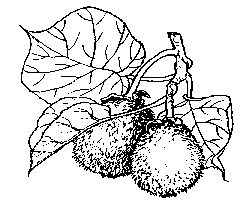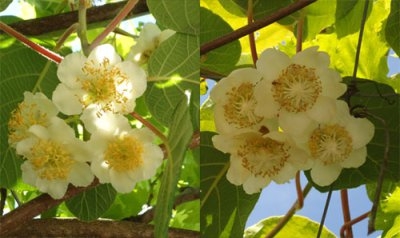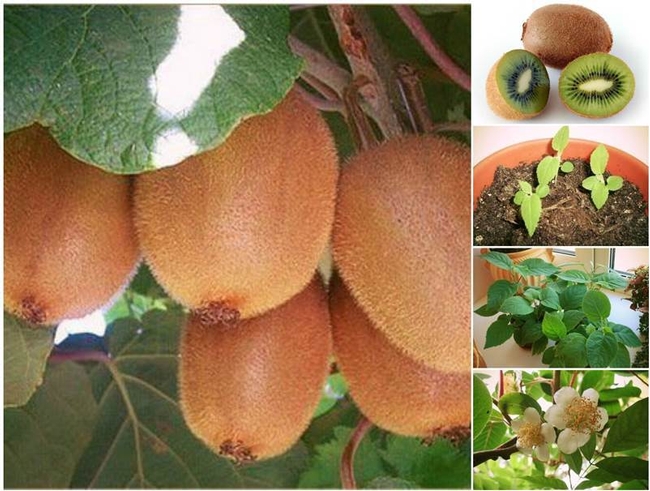Advice from the Help Desk of the
UC Master Gardeners of Contra Costa County
Image CRFG
I understand that one needs male and female plants, but this one appears to have at least 5 stalks grafted together on to the root structure. With so few bees around I was concerned about getting fruit - and we had lots of flowers. Thinking I would pollinate by hand I checked the web and then tried to determine which flowers were which, but they all looked alike to me. we did get a few kiwi, but thought we should have had more from all the flowers, and it is on the drip system, though it only runs bi-weekly to save water.
Help - what should I do next year?

male (l) & female (r) kiwi-flowers
image: http://bit.ly/1FSl2TW
MGCC Help Desk Response: Thank you for contacting the Master Gardener Help Desk. It must have been disappointing to have so few kiwifruit this year.
We recommend that when the plant blooms next year, you inspect the flowers very closely. A photo and commentary is attached to help you with that identification. If you still cannot tell the difference, then you could bring some flowers into the Help Desk and we can identify them for you. If you determine that all of your flowers are female, then you should plant a separate male vine, or graft a male vine to your existing vine.
Regarding water, kiwifruit require moderate to high amounts of water, depending on the variety. If you are growing the standard fuzzy kiwi (Actinidia deliciosa), it requires a lot of summer water. Depending upon how big the plant is, it may require 100 gallons per month or more during the summer heat.

Location: Kiwifruit will tolerate part shade but prefer a sunny location where they can ramble across some type of trellising system. The vines should be protected from strong winds. Spring gusts can snap off new growth where it emerges from the canes.
Site Preparation: Kiwifruit plants need a substantial trellis, patio cover, or other permanent place to grow upon. For the trellis system, either a single wire or T-bar system can be installed. Both have a 4 inch by 4 inch redwood post of 8 feet. For the T-bar, a 2 inch by 6 inch crossarm about 4 feet long is bolted in place. Bury the post 2 feet into the ground and cement in if at all possible. At each end of the system, a cemented deadman should be in place. Run wires across the posts and anchor tautly to the deadman. When using a patio cover, no extra trellising needs to be in place. Simply run the plant up a corner post to the top and allow the plant to then form a spoke work of shoots which would resemble an umbrella.
Soils: Kiwifruit prefer somewhat acid (pH 5 - 6.5), well-drained soils that are rich in organic matter. The leaves may show nitrogen deficiency if the soil is too basic. The plants do not tolerate salty soils.
Irrigation: Kiwifruit plants need large volumes of water during the entire growing season but must also be in well-drained soils. Watering regularly in the heat of the summer is a must. Never allow a plant to undergo drought stress. Symptoms of drought stress are drooping leaves, browning of the leaves around the edges, and complete defoliation with regrowth of new shoots when the stress is continuous. More plants probably die from water related problems than any other reason.
Fertilization: Plants are heavy nitrogen feeders which should be applied in abundance during the first half of the growing season. Late season applications of nitrogen will enhance fruit size but are discouraged as the fruit then tends to store poorly. In basic soils, a citrus and avocado tree fertilizer should be broadcast about the vine and watered in well in early March. Follow up the initial fertilizing by supplemental additions to early summer. In other areas, use a high nitrogen fertilizer which contains trace elements unless it is known that the particular soil is deficient in another nutrient. Mulching with manures and/or straws is very beneficial. However, do not put the mulch directly in contact with the vine as crown rot will occur.
Pruning: For best fruit production, pruning in the winter is a must. All pruning techniques are usually based on a "cane replacement" and differ only based on the trellising method used. Kiwi vines need to be supported and this is usually done in one of three ways: single wire, 3-5 wire on a T-bar system, or onto a patio cover. In all cases, one stem is trained up to a wire at six feet and then allowed to grow along the wire. When growth ends in a "pig-tailing" of the shoot, it is cut behind the entanglement and new a shoot allowed to grow from a leaf base. After two years multiple shoots will now emerge from the lateral mainline. During the growing season, each lateral cane will send out a new shoot about 1/3 of the way from its own starting point. The next winter, prune off the older cane at the point that it connects with last summers' new shoot. Repeat this every year.

image: icreativeideas.com
We hope that this information is helpful. Please contact us again if you have further questions or need assistance identifying the kiwi flowers.
Help Desk of the UC Master Gardeners of Contra Costa County
Note: The UC Master Gardeners of Contra Costa's Help Desk is available year-round to answer your gardening questions. Except for a few holidays, we're open every week, Monday through Thursday for walk-ins from 9:00 am to Noon at 75 Santa Barbara Road, 2d Floor, Pleasant Hill, CA 94523. We can also be reached via telephone: (925) 646-6586, email: ccmg@ucanr.edu, or on the web at http://ccmg.ucanr.edu/Ask_Us/